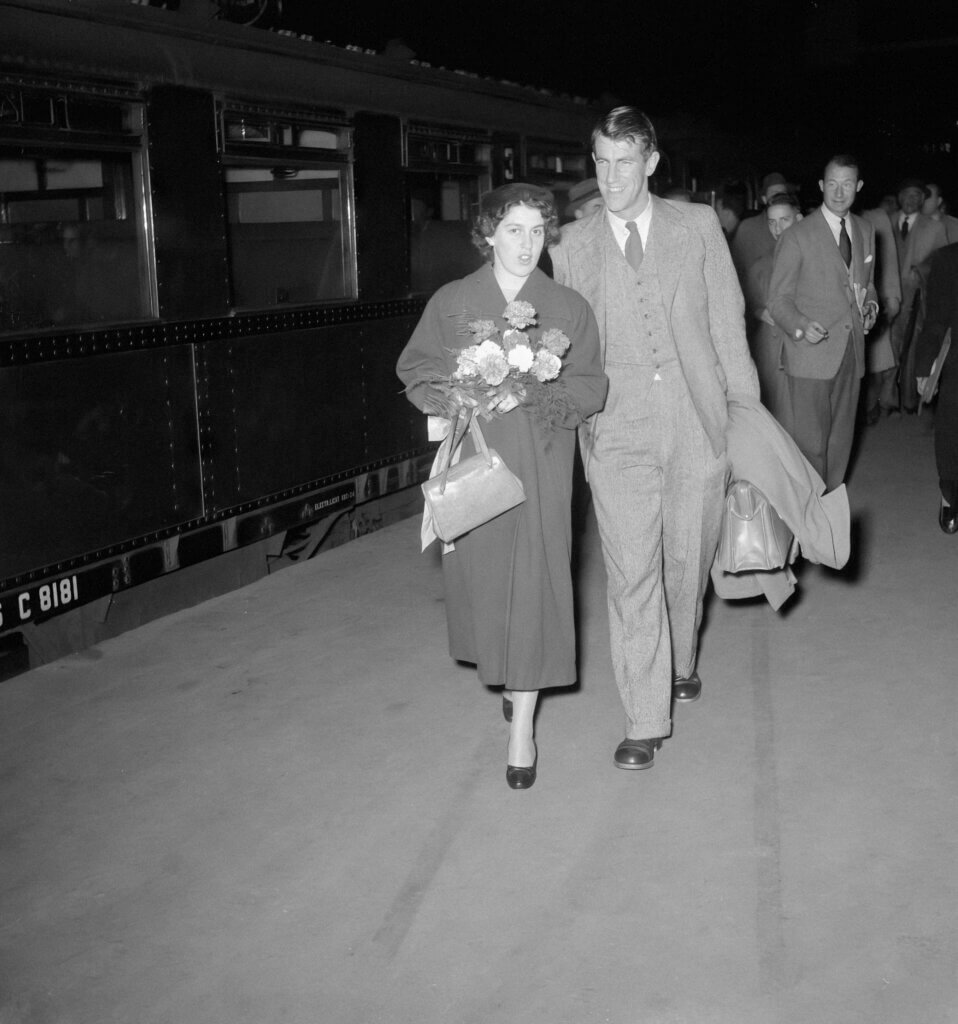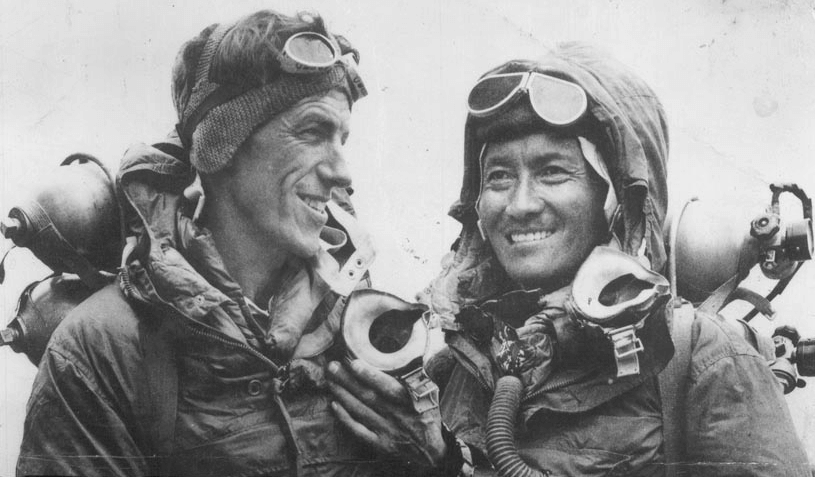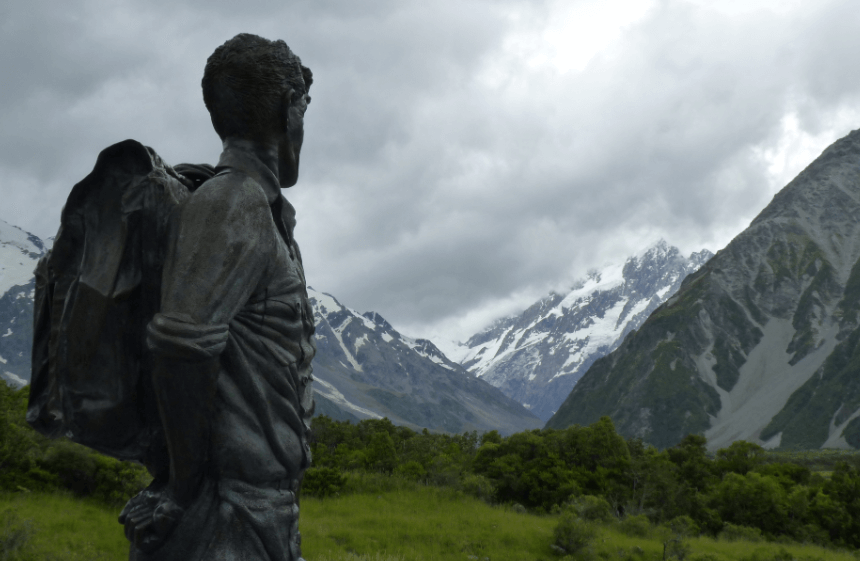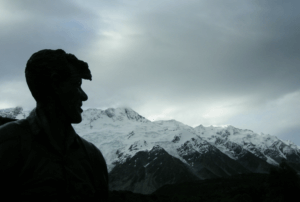Edmund Hillary, a beacon of exploration and human endurance, graced the Earth from 20 July 1919 to 11 January 2008. He was born in Auckland, New Zealand. Nestled amidst the scenic vistas of New Zealand, Hillary’s early life kindled a flame for mountaineering. This passion initially revealed itself during his secondary school years. Hillary’s passion for grand summits led him from his homeland to the Alps and, ultimately, to the Himalayas. He conquered 11 peaks over 20,000 feet there before facing Earth’s loftiest point.
The 1953 Everest Expedition, under the leadership of John Hunt, witnessed Hillary and Tenzing Norgay etch their names into history. They became the first climbers to be verified in conquering its summit. Their victory was a personal achievement and a testament to the unwavering spirit of explorers worldwide. Yet, Hillary’s pursuits stretched beyond the conquest of peaks. His journey to the expanses of the South Pole established him as the first to triumph over the Earth’s extremities. Subsequently, he conquered the mighty Everest, solidifying his remarkable legacy. He celebrated his monumental achievements, bestowing him the honour of being one of the 20th century’s 100 most influential individuals.
His post-Everest life did not dim. His adventurous spirit expanded to encompass a sincere dedication to philanthropy. In 1960, he established the Himalayan Trust, turning his efforts towards aiding the Sherpa people of Nepal. His extensive impact on exploration and his philanthropic endeavours in Nepal garnered numerous accolades, notably the Order of the Garter in 1995. In remembrance, 2008 saw New Zealand bid farewell to this colossal figure with a state funeral. The ceremony honoured a life dedicated to surmounting not only the peaks of the world but also the metaphorical mountains of humanitarian challenges.

From Auckland to Everest: The Roots and Early Days of Edmund Hillary
Edmund Hillary was nurtured under the watchful eyes of Percival Augustus and Gertrude Hillary. They were individuals imbued with a potent blend of resilience and adventure. The tales of his father, Percy, resonated with narratives of courage. Percy had served with distinction at Gallipoli alongside the 15th (North Auckland) Regiment before a medical discharge in 1916. Upon returning to the emerald isles of New Zealand, Percy united in marriage with Gertrude. Edmund’s lineage also whispered stories from distant shores: his grandfather, Edmund Raymond, a watchmaker by trade from Lancashire, England, had set sails towards northern Wairoa in the mid-19th century, marrying Annie “Ida” Fleming from Ireland.
In 1920, a shift to Tuakau, located south of Auckland, marked a pivotal chapter in Hillary’s early life. Percy allocated eight acres as a nod to his military service, pivoting his career towards journalism and apiary. He established himself as the inaugural editor of the Tuakau District News. The young Edmund, his sister, June, and his brother, Rex, were enveloped by an ethos of diligence and enterprise.
Physical stature and confidence initially eluded Hillary during his initial years at Auckland Grammar School. He navigated through a sea of taller peers with a reserved demeanour, unable to partake in after-school activities due to his extensive commute. Nevertheless, an eventual growth spurt saw him towering at 6 feet 2 inches, and an engagement with the disciplined world of boxing gradually ushered in newfound confidence, subtly laying down foundational stones for a man who would one day conquer not merely the peaks of the Earth, but the heights of human endeavour.
Scaling Personal Peaks: Edmund Hillary’s Early Forays into Beekeeping and Mountaineering
A pivotal school trip to Mount Ruapehu at 16 ignited Edmund Hillary’s ardour for climbing and his desire to explore the world. His youthful escapades were defined more by tramping and outdoor adventures than by academia, evidenced by his shift of interest from studying at Auckland University College, which he abandoned in 1938 after two unfruitful years, to a more tactile engagement with nature.
Meanwhile, alongside his father and brother Rex, Edmund dove into beekeeping. Managing 1600 hives, handling hefty honeycomb boxes, and enduring a daily barrage of bee stings did not deter him. Summer was dedicated to bees, while winter was reserved for his growing passion: climbing. The family was deeply embedded in the beekeeping world, with his father editing “The N.Z. Honeybee” and his mother, Gertrude, gaining renown for her queen bee breeding and selling skills.
Simultaneously, the philosophy of “Radiant Living,” advocated by Herbert Sutcliffe, significantly influenced the Hillary family, who became foundation members in 1938. Gertrude undertook secretarial duties for the movement in 1939, while Edmund explored the philosophy more deeply. He ventured to Gisborne as Sutcliffe’s assistant and, in 1941, became a certified teacher of Radiant Living. Moreover, his involvement with the Radiant Living Tramping Club facilitated a deeper exploration of the outdoors, particularly in the Waitākere Ranges.
In mountaineering, Hillary marked a significant milestone in 1939, conquering Mount Ollivier near Aoraki/Mount Cook in the Southern Alps. The climb was a physical and social accomplishment, introducing him to Harry Ayres and George Lowe. These men would become more than mere acquaintances, evolving into what Hillary would describe as “the first real friends I’d ever had”. His initial adventures thus sewed the seeds for extraordinary future expeditions, lifelong friendships, and a philosophy that would guide his interactions with the world around him.
Edmund Hillary: Navigating Skies and Conscience During WWII
Amid the seismic tumult of World War II, Edmund Hillary found himself wrestling with moral quandaries even as global conflict loomed large. His initial venture to join the Royal New Zealand Air Force (RNZAF) was swiftly aborted, with Hillary confessing his application was thwarted by a “harassed religious conscience”. However, as the war escalated and conscription emerged in 1943, the Japanese threat in the Pacific compelled him to enlist, navigating through ethical and actual tempests.
His service saw him taking to the skies, where he joined the RNZAF, applying his skills as a navigator for No. 6 Squadron and, later, No. 5 Squadron, utilising Catalina flying boats as their vessel of choice through the expansive and dangerous Pacific. A posting in 1945 brought Hillary to the exotic and fraught locales of Fiji and the Solomon Islands. Yet, his service was not without personal peril; he suffered severe burns in an unforeseen accident in the Solomon Islands. This episode was a dramatic pause in the storied journey of a man more often associated with the cold ascents of towering peaks than the fiery dangers of war-torn islands. It added a complex chapter to Hillary’s exploration and humanitarian endeavours tale.
Conquering Heights and Depths: Edmund Hillary’s Riveting Expeditions
Embarking on an exploration that would etch his name into history, Edmund Hillary joined a motley of adventures. These adventures culminated in feats on the towering crags of the Himalayas. His journey towards high peaks commenced in 1948 with the ascent of Aoraki/Mount Cook’s south ridge. That same year, he witnessed Hillary’s engagement in a strenuous rescue mission on La Perouse. This is when he knit bonds of camaraderie with climber Norman Hardie.
Edging towards a higher calling, 1951 saw him intertwining his destiny with the enigmatic Everest. This became an intrinsic part of a British reconnaissance expedition spearheaded by Eric Shipton. This endeavour seamlessly tethered him to the monumental 1953 British attempt on the world’s highest peak. A year before that, in 1952, Hillary and George Lowe, under Shipton’s leadership, dared to conquer Cho Oyu. Their ambition, however, met an insurmountable obstacle as a feasible route from Nepal was non-existent. Unperturbed, Hillary and Lowe traversed the Nup La pass into Tibet, finding themselves at the historic Camp II on the northern side, a testament to previous expeditions’ unyielding spirit.
Subsequent participation in Everest reconnaissance missions in 1951 and 1952 showcased Hillary’s formidable mountaineering prowess, inevitably drawing the gaze of Sir John Hunt. Leading an expedition sponsored by the Joint Himalayan Committee, Hunt identified in Hillary a steely resolve and indomitable strength essential for the looming assault on Everest’s towering summit in 1953.

Ascending Ambitions: Hillary, Hunt, and the Imprint of Everest’s Call
In 1949, Everest’s renowned summit route, governed by Chinese-controlled Tibet, was unequivocally closed, ushering in a period where Nepal permitted merely a solitary or duo of expeditions annually. A particularly poignant episode in this era was the 1952 Swiss expedition, which experienced an untimely retreat 800 feet below the peak. It was also beleaguered by inclement weather and malfunctioning oxygen sets despite the vigorous efforts of participants like Tenzing.
During these trying times, Edmund Hillary, a climber embodying potent energy and an indomitable mindset, ascended into the limelight. In 1952, a significant development unfolded as Hillary and Lowe were welcomed to participate in the 1953 British attempt on Everest by the Joint Himalayan Committee. Although Eric Shipton was initially slated to spearhead the endeavour, leadership reins were handed over to John Hunt. This triggered initial resistance from Hillary. Nevertheless, Hillary soon warmed to Hunt, who exuded an unmistakable vigour and steely resolve that left an indelible impression on the climber.
Hillary’s audacious exploits on the Himalayas, not only on Everest but also at a probable summit party, were underscored by Hunt’s laudations. Furthermore, they recognised his analytical mind that effortlessly surmounted unvalidated barriers. These laudations highlighted his palpable energy and analytical mind that effortlessly surmounted unvalidated obstacles. These affirmations were not mere words, for Shipton had prognosticated Hillary’s indispensable role in the expedition a season before, highlighting his exceptional strength and insatiable energy.
The leadership dynamics interestingly evolved when the ascent teams were announced. Despite Hillary’s aspiration to scale with Lowe, the expedition named two distinct duos: Tom Bourdillon with Charles Evans and Hillary with Tenzing. Acknowledging the shift, Hillary meticulously cultivated a robust working relationship with Tenzing. Tenzing was a Sherpa he admired for possessing a personal ambition that soared substantially higher than his counterparts.
Ascend Against Odds: Hillary’s Perilous Path to Everest’s Apex
Edmund Hillary was not only a climber whose physique was as lean and rugged as the mountain terrains he ventured upon. As his roommate and cameraman Tom Stobart recalled, he was a problem-solver of formidable efficiency. A particular incident involving the repair of a dismantled rubber torch revealed Hillary’s unspoken promise of resolution, encapsulated in the seemingly non-committal phrase, “Let’s give it a go”. This determination, veiled in assurance, resonated deeply with those who encountered him, including George Lowe, a fellow countryman and compatriot in many expeditions.
In 1953, under the leadership of Hunt, a meticulous expedition was mounted to conquer Everest. It involved over 400 individuals, 10,000 pounds of baggage, and the essential support of 20 Sherpa guides and 362 porters. Hillary navigated a path through the treacherous Khumbu Icefall. This was a testament to his analytical mindset towards the myriad challenges presented by the towering peak.
Establishing itself in March, the base camp evolved meticulously, setting the final camp at the South Col at an altitude of 25,900 feet by May. Tom Bourdillon and Charles Evans undertook the initial attempt towards the summit. However, fate pulled them back 300 vertical feet short of the pinnacle due to the malfunction of Evans’s oxygen system. Thus, the gauntlet was passed to Hillary and Tenzing.
Faced with harsh nature, a two-day delay tested their resolve as snow buffeted the South Col. Yet, on 28 May, supported by Lowe, Alfred Gregory, and Ang Nyima, Hillary and Tenzing initiated their ascent. They pitched a tent at 27,900 feet while their support team retreated. Hillary brought to bear the same tenacity and unspoken assurance that had softly echoed in a Kathmandu room months prior, now amplifying across the majestic expanses of the Himalayas.
Conquering Everest: Hillary and Tenzing’s Triumph at the Top of the World
A chilly morning unveiled the critical moment of Edmund Hillary and Tenzing Norgay’s groundbreaking journey, with Hillary discovering his boots had surrendered to the icy Everest exterior, frozen rigidly solid. Devoting two hours to delicately warming them over a stove, the pair, laden with 14-kg packs, engaged the mountain for their final ascent, entwining them with the imminent challenges and tangible anticipation.
The noteworthy “Hillary Step”, a formidable 12-metre rock face, posed the ultimate test before their imminent triumph. Hillary navigated through a narrow crack between snow and rock with an indomitable spirit, assiduously creating a path towards the peak. In calculated motions, Tenzing joined him in navigating the meticulously chopped steps. Upon reaching a ridge that gradually descended to the north and sighting a rounded snow dome, they heralded their arrival at the pinnacle of Everest.
The remarkable achievement was delicately noted in Tenzing’s 1955 autobiography. This is where he credited Hillary with taking the inaugural step onto the summit. At 11:30 a.m., they reached the zenith of the Earth, Everest’s summit, soaring 8,848 metres above sea level, marking a monumental moment in mountaineering history.
During a brief yet infinitely significant 15-minute sojourn at the summit, Hillary photographed Tenzing, posed with his ice-axe, against their formidable conquest. Commemorative gestures adorned the apex, with Tenzing leaving chocolates as an offering, symbolic of their respect and reverence for the mighty Everest.
The extensive expedition managed to access the South Peak earlier in May, but altitude and exhaustion whittled the summit team down to Hillary and Tenzing. As they stood victorious at the highest point on Earth, their achievement encapsulated not only a personal triumph. It also marked a monumental milestone, emblematic of the unyielding pursuit of reaching new heights.
Conquering Horizons: Hillary’s Adventurous Legacy Beyond Everest
Edmund Hillary, the pioneering spirit recognised for the victorious Everest expedition, left an indelible mark on the landscape of exploration. He exhibited an unyielding drive that took him beyond the towering peaks of the Himalayas. After his monumental conquest in 1953, Hillary aimed to venture further. He scaled ten additional heights within the formidable mountain range across multiple expeditions from 1956 to 1965. His exploratory spirit was not confined to the high-altitude realms. It also spanned to the frosty expanses of the poles. Remarkably, he etched his name in history by reaching the South Pole during the Commonwealth Trans-Antarctic Expedition in 1958. He was the first to achieve this feat overland using motor vehicles since the treks of Amundsen and Scott in the early 20th century. This accomplishment solidified his legacy as a trailblazer in polar exploration.
The mystery-shrouded slopes of the Himalayas invited Hillary back in 1960 for the Silver Hut expedition, an endeavour he spearheaded alongside Griffith Pugh. This expedition revealed a compelling truth about the formidable Everest: conquering the giant was possible without supplemental oxygen. This was achievable through an extensive acclimatisation period at elevated altitudes, precisely 20,000 feet, for an enduring six months. An attempt to ascend Makalu, the world’s fifth-highest peak, while part of this mission met with an unfortunate failure despite ten months of rigorous effort and meticulous planning.
Hillary’s Extraordinary Expeditions: From Yeti Mysteries to Polar Extremes
In a fascinating detour towards the mythical, Hillary’s expedition delved into the enigma of the abominable snowman or the “Yeti”. This venture whisked him to secluded temples, home to the reputed “Yeti scalps”.
Yet, the investigations revealed that the scalps originated from more mundane creatures like bears and goat antelope. This debunked mystic theories, placing rationality at the forefront of understanding local phenomena.
Hillary’s adventures also sailed him through the serene yet challenging waters of the Ganges in 1977, leading a jetboat expedition titled “Ocean to Sky”. Hillary perpetually sought the thrill of uncharted terrains. He lent his voice as a commentator on Antarctic sightseeing flights between 1977 and 1979. Moreover, he accompanied astronaut Neil Armstrong over the Arctic Ocean and landed on the North Pole in 1985. His ventures spanned both polar extremes, showcasing his enduring commitment to exploring the great unknown. His feats serve as a testament to human endurance and curiosity. Moreover, they are also a beacon, inspiring ensuing generations to undertake what is now hailed as the Three Poles Challenge.
Even in his later years, Hillary’s connection to the extremes of the Earth remained intact. A voyage to Antarctica in 2007 marked the celebration of the 50th anniversary of Scott Base. It underlined a lifetime intertwined with the planet’s utmost boundaries, demonstrating a timeless commitment to exploring the great unknown.
New Zealand Celebrates Edmund Hillary’s Legacy
Edmund Hillary, a name synonymous with adventure and tenacity, garnered the admiration of the public over the years. He also has critical acclaim and honours from esteemed organisations and nations. In the year that saw him conquer Everest, 1953, he received the appointment as Knight Commander of the Order of the British Empire. Moreover, he graciously received the Queen Elizabeth II Coronation Medal, and subsequent years brought him accolades. This includes the prestigious Polar Medal in 1958 and his appointment as the fourth Order of New Zealand member in 1987.
Within his homeland, his visage has adorned New Zealand’s $5 note since 1992, with the impressive Aoraki / Mount Cook as a chosen backdrop, rather than the predictable Everest. The Reader’s Digest polls also revered the mountain man as “New Zealand’s most trusted individual”. It indicates his deeply rooted influence and respect among his compatriots from 2005 to 2007.
The Sir Edmund Hillary Outdoor Pursuits Centre emerged as his favoured charity in a poignant tribute to his enduring legacy. It reflected his passion for introducing youth to the profound impact of outdoor experiences. Further immortalising his presence, a bronze statue reaching 2.3 metres stands firm outside The Hermitage Hotel at Mount Cook Village. Hillary unveiled it himself in 2003. His name permeates daily life in New Zealand, gracing streets, institutions, and organisations, such as the Sir Edmund Hillary Collegiate in Otara.
Across the expanses of Antarctica, the Hillary Coast and the undersea Hillary Canyon etch his name into the Earth’s extremities. This ensures that the spirit of his adventures continues to inspire generations of explorers, both in his homeland and globally. His life and exploits form an enduring narrative of audacity, exploration, and humble humanitarianism, perpetually echoing in the frosty landscapes he once traversed.
Enduring Peaks and Valleys: The Personal and Philanthropic Journey of Edmund Hillary
Nestled between the lush landscapes of Anawhata and North Piha, Whites Beach, a tranquil Auckland west coast enclave, harboured Edmund Hillary’s bach. It is essentially a modest beach house, yet a profound sanctuary from the pervasive gaze of media scrutiny. The retreat, eloquently dubbed his “place of solace” by a close acquaintance, provided respite and anchored the Hillary family’s long-standing ties to the area. Edmund, forever entwined with international expeditions and travels, once confided, “This is the place I want to see out my days”.
Marriage to Louise Mary Rose in the wake of the formidable Everest ascent in 1953 brought three children into Edmund’s life: Peter, Sarah, and Belinda. Tragically, Louise and Belinda perished in a devastating plane crash near Kathmandu airport in 1975 while en route to Phaphlu. In this village, Edmund was immersed in the construction of a hospital. The sorrowful chapter did not preclude new beginnings, and in 1989, Edmund found companionship and love again with June Mulgrew, widow of his dearly departed friend, Peter Mulgrew.
Peter Hillary, Edmund’s son, not only inherited his father’s name but also his preference for the towering allure of Everest. In 1990, he scaled the emblematic peak, returning in May 2002 alongside Jamling Tenzing Norgay, son of the late Tenzing Norgay. This was part of a poignant expedition to commemorate the 50th anniversary of the historic ascent by their fathers. Embracing the symbiotic relationship between personal life and nature’s vast expanse, Edmund’s story intertwines tranquil New Zealand beaches and the formidable, icy facades of Himalayan peaks. It echoes a life where personal tales and the call of the wild interweave seamlessly.

Uplifting the Himalayas: Hillary’s Legacy of Altruism
In the rugged terrains of the Himalayas, Sir Edmund Hillary embarked on a different kind of ascent after his triumphant Everest expedition. He started a journey towards uplifting the lives of the Sherpa people of Nepal. Upon the ding of the Himalayan Trust in 1960, Hillary pledged himself to philanthropic endeavours. He steered the organisation until his demise in 2008, cultivating a legacy cemented in benevolence as much as adventure. His undeterred efforts burgeoned into the construction of numerous hospitals and schools in the secluded expanses of the Himalayas. This aided in bringing sustenance and education to these remote communities.
Elevating his philanthropic pursuits beyond borders, Hillary embraced the honorary presidency of the American Himalayan Foundation, a non-profit entity from the United States. He profoundly enhanced living conditions and ecological balance in the mighty Himalayas. Concurrently, his role as Honorary President of Mountain Wilderness underscored a global commitment, with the international NGO devoted to shielding the pristine sanctity of mountain ranges across the planet. Therefore, Hillary conquered peaks and championed a noble cause. This is where he ceaselessly advocated for the welfare and protection of the elevated realms he had once tread.
Advocacy and Diplomacy: Hillary’s Political Journey
Embarking on a voyage into politics and advocacy, Edmund Hillary, the seasoned mountaineer, revealed another facet of his multifaceted personality. His unwavering support for the Labour Party became prominently visible in the 1975 New Zealand general election when he actively participated in the “Citizens for Rowling” campaign. He also actively engaged in political endeavours, becoming a point of discussion and even influencing official appointments. His political involvement ostensibly thwarted his nomination for the position of governor-general in 1977. This resulted in the choice of Keith Holyoake instead.
Simultaneously, Hillary emerged as a voice in the realm of social advocacy. In 1975, his belief in women’s reproductive rights led him to serve as a vice president for the Abortion Law Reform Association of New Zealand. This was a significant role in a national pro-choice advocacy group. His commitment to this cause remained steadfast, as seen through his patronage of REPEAL. REPEAL is an organisation ardently working towards repealing the stringent Contraception, Sterilisation, and Abortion Act of 1977.
A few years later, Hillary expanded his horizons into international diplomacy. In 1985, his diplomatic career took flight when he was appointed New Zealand’s High Commissioner to India. His role did not limit him to a single country. Still, it extended his responsibilities as he concurrently served as the High Commissioner to Bangladesh and Ambassador to Nepal, dedicating four and a half years based in New Delhi.
Thus, Hillary showed that he didn’t confine his journey to the towering peaks. The journey also wove through the complex terrains of societal and political realms. This involved navigating the political landscapes and advocating for societal shifts.
Final Ascent: Edmund Hillary’s Farewell
In the tranquil Hauraki Gulf of Auckland, where the gentle lapping of waves whispers to the shoreline, a portion of Edmund Hillary’s ashes were tenderly scattered on 29 February 2008, aligning with his final wish. His remarkable life journey, imprinted with audacious adventures atop the world and deeply etched into New Zealand’s heritage, came to a serene close. In 2010, planners ultimately retracted a subsequent plan to disperse the remaining ashes atop Everest’s solemn and towering summit. The residue now honourably rests at a Nepalese monastery nestled near the monumental peak.
Earlier, on 11 January 2008, Auckland City Hospital witnessed Hillary’s tranquil departure from this world, succumbing to heart failure. Across New Zealand, from its luscious landscapes to the expanses of Scott Base in Antarctica, flags solemnly bow at half-mast. It pays homage to a man whose feats transcended beyond mere exploration. Prime Minister Helen Clark encapsulated the nation’s sentiment, recognising his passing as a “profound loss to New Zealand”.
The soft echo of footsteps within Auckland’s Holy Trinity Cathedral paid tribute to Hillary on 21 January as his casket lay silent, dignified. Mourners gathered and offered their respectful farewells during a state funeral on 22 January 2008 before gently consigning his body to the flames. His spirit continues to illuminate the pathways of adventurous hearts worldwide, leaving a lasting legacy.
Honouring a Legacy: Global Tributes to Edmund Hillary
There’s no doubt that the annals of mountaineering encapsulate the legacy of Sir Edmund Hillary. It is also solidified in numerous tributes worldwide, revealing the global impact of a singular, towering figure. Various memorials and honours stand testament to his influence, from the rugged terrains of New Zealand to the distant, icy peaks of Pluto.
In Lukla, Nepal, the doorway to Mount Everest, the local airport gracefully bears the name Tenzing–Hillary, honouring the duo that popularised its very construction. Far from those heights, Queen Elizabeth II, New Zealand’s Prime Minister Helen Clark, and other attendees memorialised Hillary’s stature on an international stage. This was during a solemn service of thanksgiving held in 2008 at Windsor Castle.
Establishment of the Hillary Shield
The Hillary Shield was established in a blend of sporting spirit and homage, symbolising rugby rivalry and respect between England and New Zealand. Moreover, the New Zealand Post issued the Duke of Edinburgh’s Hillary Award and a quintet of commemorative stamps. This was to embed his memory in the nation’s cultural and social fabric.
Widespread respect for Hillary found poignant expression in the “Summits for Ed” tribute tour orchestrated by the Sir Edmund Hillary Foundation. This significant journey traversed from Bluff to Cape Reinga. It now encourages New Zealanders to climb local hillocks and offer pebbles for a memorial at Mt Ruapehu.
The “Hillary 88” Honour
Further honour came melodiously through “Hillary 88”, endorsed by Lady Hillary as the official global memorial song. In contrast, authorities realised a quietly reflective homage by naming the Hillary Trail a four-day track along Auckland’s west coast. They also designated Hillary Ridge on Aoraki / Mount Cook, recognising his familial and adventurous connections to the landscape.
Internationally, his legacy finds permanence in names – a proposed Hillary Peak in Nepal and the distant Hillary Montes on Pluto. The Sir Edmund Hillary Mountain Legacy Medal and the Sir Edmund Hillary Archive memorialise his significant contributions to mountain cultures and ecosystems. The Auckland War Memorial Museum curates the archive, and UNESCO recognises it.
The commitment to global impact found structured expression between 2016 and 2020 through the Edmund Hillary Fellowships. This initiative sought to incubate ventures with positive global repercussions by offering a Global Impact Visa, rooting Hillary’s legacy in past achievements and future innovations.
Together, these tributes and initiatives weave a multifaceted memory of Hillary, honouring a man whose footsteps marked more than just the snows of Everest, resonating through diverse terrains, generations, and, indeed, across the cosmos.


